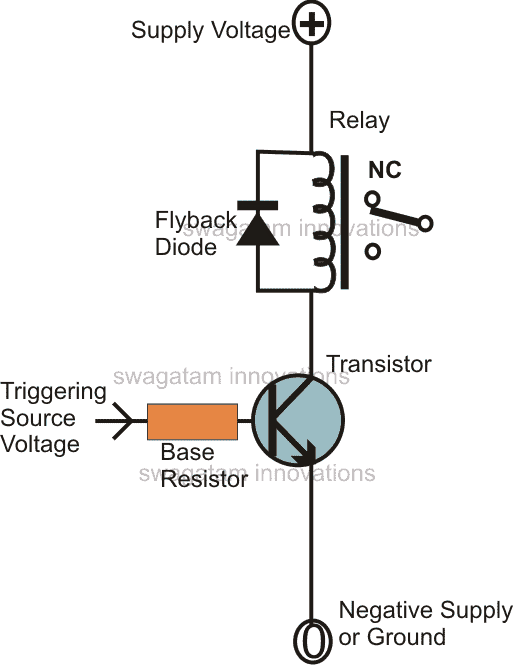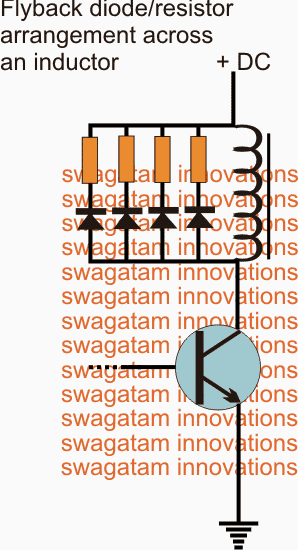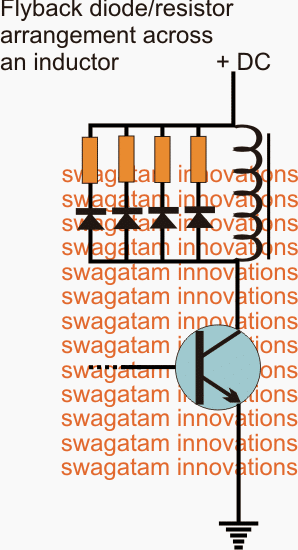In this post we systematically discuss how to connect diodes in parallel for getting upgrading the overall current specifications of the assembly. This requires special circuit arrangement to ensure uniform current distribution between the devices.
Whenever an inductor based load is involved in a DC circuit, incorporating a back EMF protection diode or a freewheeling diode becomes imperative in order to protect the BJT or the mosfet responsible for driving it.
How to Calculate Parallel Diode
However calculating and connecting diodes in parallel is never an easy task to implement.
We all know that just like capacitors inductors have the property of storing and reverting electrical energy across itself.
The storing of the electrical energy takes place when the inductor is subjected to a potential difference across its leads while the throwing back or discharging the stored electrical energy happens the moment this potential difference is removed.
The above explained "kicking back" of the stored energy across an inductor or a coil is termed as "back EMF"and since the polarity of the "back emfs" is always opposite to the applied potential difference becomes a serious threat to the device employed for controlling or driving the inductor.
High Current Diodes for Back EMF Protection
The threat lies in the fact that the reverse voltage inflicted by the inductor tries to make its way through the associated power device such as a BJT with a reverse polarity causing a instant damage to the device.
A simple idea to counter this issue is to add a rectifier diode directly across the coil or the inductor, where the cathode connects with the positive side of the coil while the anode towards the negative.
Such diode arrangement across DC coils is also called freewheeling or a flyback diode.
Now whenever the potential across the coil is removed, the generated back emfs swiftly finds its path through the diode and gets neutralized instead of forcing through the driver device.
A classic example of this phenomenon may be witnessed in a BJT driven relay driver stage, you might have come across plenty of these in numerous different circuits. A diode could be normally seen connected across such relay drivers stages, which is done for protecting the BJT from the lethal back emfs kicked from the relay coil every time it's switched OFF by the BJT.
Flyback High Current Diode Schematic

A relay being a relatively small load (high resistance coil), normally a 1 amp rated 1N4007 diode becomes more than sufficient for such applications, however in cases where the load is relatively huge or the coil resistance is very low, the generated back emfs could be equivalent to the applied current levels, meaning if the applied current is in the range of 10 amp, the reverse emf would also be around this level.
To absorb such massive jolts the reverse back emf, the diode too must be robust with its amp specs.
Normally, in such cases where the back emf could be above 10 or 20 amps, finding a suitable single diode becomes difficult or too expensive.
A good way to counter this is to connect many smaller rated diodes in parallel, however since diodes just like BJTs are semiconductor devices, don't go well when connected in parallel.
The reason being, each diode connected in the parallel string could have a slightly different switch ON levels making the devices conduct separately and the one which switches ON first becomes responsible of taking on the greatest bulk of the induced current, which itself makes the particular diode vulnerable.
Therefore, in order to solve the above concern each diode must be added with a series resistor, appropriately calculated for the freewheeling application as per the given parameters.
Connecting Diodes in Parallel
The procedure of connecting diodes in parallel correctly may be done in the following manner:
Suppose the maximum assumed emf current across the inductor is 20 amps, and we prefer to use four 6 amp diodes as the freewheeling diodes across this coil, implies that each diode should share around 5 amp current, the same applies for the resistors also, which may be connected in series with them.
Using Ohm's law we can calculate the resistors such that they generate minimum safe resistance together but singly offers an optimal high resistance forcing the current to share the paths equally across all the diodes.
Generally a 0.5 ohm resistance will be quite safe for safeguarding the power device, therefore 0.5 x 4 becomes 2 ohms, so each diode could be 2 ohms rated.
The wattage together must be rated for handling the entire 20 amps, therefore dividing 20 by 4 gives 5, meaning each resistor must be rated at 5 watts each.
Using Resistors in Series with Diodes to Prevent Thermal Runaway

